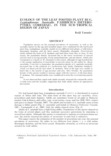Population surveys on the seasonal prevalence of occurrence, as well as the mortality factors in the egg and nymphal stages were conducted for the leaf-footed plant bug, Leptoglossus australis, mainly in two different host plants, a wild melon, Bryonopsis laciniosa, and the bitter gourd, Momardica chranatia. Overwintered adults utilized the fruits of B. laciniosa and bred there from May to June. In this season, the population density increased due to the lower occurrence of natural enemies such as an egg parasite, Gryon pennsylvanicum, and ant species. Adults also immigrated to oviposit on M. chranatia in this season, although no eggs hatched due to the regular application of insecticides to prevent injury by the melon fly, Dacus cucurbitae. From July to September, the population density of L. australis markedly decreased due to the outbreak of a herbivorous lady beetle, Epilachna boisduval, which was destroyed the host plant, B. laciniosa. Most of the eggs were unable to hatch due to the attacks of egg parasites and ants. After October, the population density of this species tended to increase again with the recovery of the host plant, B. laciniosa. The emerged adults were considered to form the overwintering population.
It was observed that caged male adults strongly attracted the conspecific adults of both sexes and the nymphs, suggesting that male adults release an aggregation pheromone.

